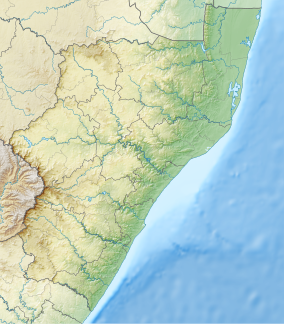Oribi Gorge
This article needs additional citations for verification. (August 2012) |
| Oribi Gorge | |
|---|---|
 View from near Baboon's Castle, Oribi gorge | |
Oribi Gorge on the map of KwaZulu-Natal | |
| Location | KwaZulu-Natal, South Africa |
| Coordinates | 30°43′11″S 30°16′12″E / 30.7197°S 30.27°E[1] |

Oribi Gorge is a
Erosion by these rivers have carved out nearly 30 kilometres (19 mi) of spectacular kloofs and crags, covered with subtropical vegetation.[2] In the gorge, the dense forest on the sandstone slopes is home to various small mammals, while the large leguaans excavate their burrows along the riverbanks.[3]
At the base of the cliffs of both gorges the basement rocks are part of the Namaqua-Natal Metamorphic Province, which is over 1000 million years old. The cliffs themselves are formed by Msikaba formation sandstones deposited by fluvial environment about 365 million years ago.[4] Downstream from the gorges, is a large surface mine producing cement from a limestone deposit. The road through Oribi Gorge was built by Italian prisoners of war.
Oribi Gorge derives its name from the oribi, a small antelope that lives in the gorges.
Oribi Gorge Nature Reserve

Oribi Gorge Nature Reserve is a park located along the bottom of the Oribi Gorge at the confluence of the Mzimkulu River and Mximkulwana River, being approximately 27 kilometres (17 mi) long, and 1 kilometre (0.62 mi) wide at its widest point. It was proclaimed a protected state forest in 1950.[5]: 330
Animals
In addition to the oribi and
-
Samango monkey
-
bushbuck
References
- ^ "Oribi Gorge Provincial Nature Reserve". protectedplanet.net.
- ^ Glen, H. F. (1996). "A description of the vegetation of Oribi Gorge Nature Reserve, Natal, part I". Trees in South Africa. 46. Johannesburg, South Africa: Tree Society of Southern Africa: 18–27.
- .
- ^ Thomas, R. J. (1988). "The petrology of the Oribi Gorge Suite; Kibaran charnockitic granitoids from southern Natal". South African Journal of Geology. 91 (2): 275–291.
- ISBN 978-0-620-04650-3.)
{{cite book}}: CS1 maint: others (link - ^ Bourquin, O. & Mathias, I. (1994). "The vertebrates of Oribi Gorge Nature Reserve: 1". The Lammergeyer. 33: 35–44.
External links
- Ezemvelo KZN Wildlife (previously known as Natal Parks Board)
- Oribi Gorge Information Page
- 360 degree Virtual Tour of Oribi Gorge








